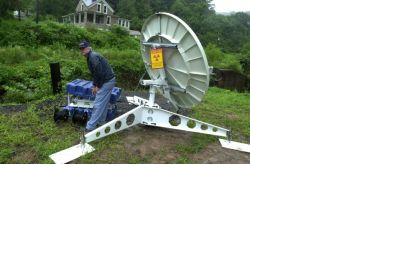The Satellite Communication team of UN-SPIDER under the leadership of Yusuf Hascicek has completed a review article on “The Use of Satellite Communications for Disaster Management and Emergency Response”, which has been submitted to the International Journal of Emergency Management for publication.
The Satellite Communication team of UN-SPIDER under the leadership of Yusuf Hascicek has completed a review article on “The Use of Satellite Communications for Disaster Management and Emergency Response”, which has been submitted to the International Journal of Emergency Management for publication. The article states that: In disaster situations, communication is vital for organizing and coordinating Search and Rescue (SAR) operations. In some disasters it may not be possible to use the existing terrestrial communication network due to damaged infrastructure, broken cables and/or energy sources, overload on the network, or there might not be any existing communication network. To overcome the damaged network problem and support the activities to mitigate the effects of a disaster, satellite communications are used, since they provide a robust, reliable, flexible, easy to deploy capacity, high bandwidth, and a long coverage range. This paper provides an overview of the use of satellite communications for disaster management and emergency response. It is intended to serve as a resource for disaster managers and first responders.
The authors come to the following conclusion: Since communication satellites are geostationary, each one has a well defined area of coverage. Therefore each country or community should define which satellite or satellite-operator covers their region, and maintain agreements with them to utilize their services. Few big satellite operators may have many communication satellites to cover most of the globe. This also suggests that regional mechanism may be more appropriate for the use of satellite communications for disaster management and emergency response.
As we are experiencing more and more major disasters, the awareness and the importance of the satellite communications for disaster management and emergency response is increasing. As new methods and technologies are being developed, the usability improves and costs to access these technologies are decreasing. As a result of these improvements and increasing awareness, countries allocate more resources into this area, and some of them build their own communication satellites for disaster situations and early warning systems.
As the new platforms and organizations are forged the international collaboration and co-operations increases. This might lead to the notion of overpopulation or duplications. But with the rate of need for disaster relief, let alone prevention and preparedness, there is still not enough capacity to cover all the disasters around the globe. But there is a need for coordination so that much needed help does not get duplicated in a disaster while others go without being responded to.
The paper will be available on the following website when the review-process has been finished
http://www.inderscience.com/browse/index.php?journalCODE=ijem

